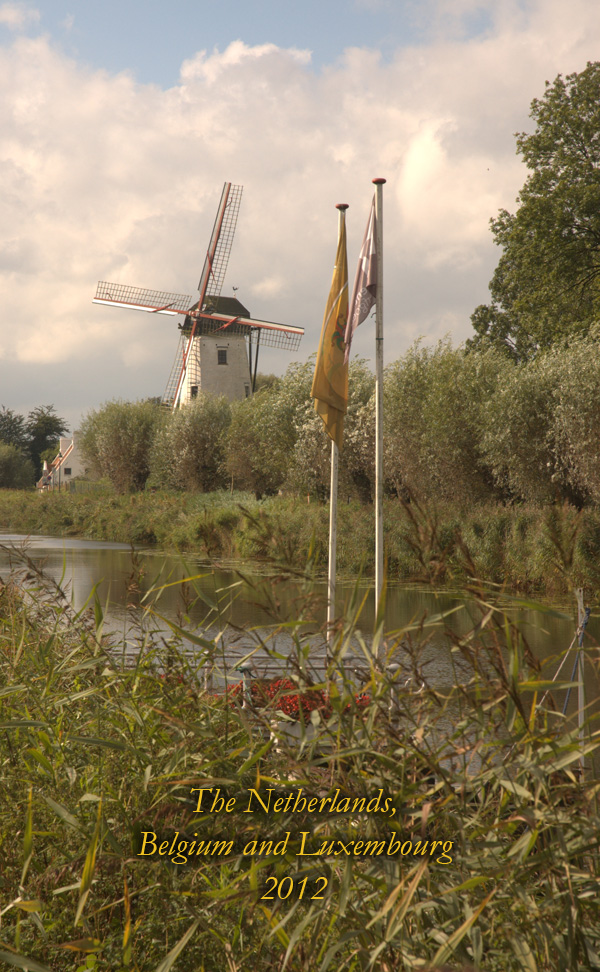
On September 17th, 2012, we flew via Air Transat from Toronto to Amsterdam arriving early Tuesday morning (Sept. 18).
It was raining as we made our way to B&B Baldrich to leave our bags and head out for a light breakfast in a nearby café. By the time we returned, about an hour later, to settle into our room and change into dryer clothes, the sky was clearing so, we spent the afternoon exploring on foot, pausing at one point to watch people engaged in their afternoon sidewalk chess game.
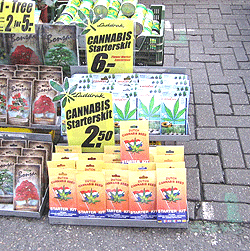 Then we wandered through a huge outdoor flower/plant market, browsing at tulips bulbs and cannabis seeds, and began to feel that we were truly in the Netherlands.
Then we wandered through a huge outdoor flower/plant market, browsing at tulips bulbs and cannabis seeds, and began to feel that we were truly in the Netherlands.
George came upon a terrific pipe store, Smokiana and spotted the clay double barrel pipe he would eventually return to buy.
We took an initial brief stroll through the Red Light District and stopped for supper at Haesjie Claes near the Spui. It was a lively spot with great food: an oven stockpot of fish with grated cheese for George and a fresh vegetable dish with mashed potatoes, mushrooms and vegetable croquettes for Tana. The chocolate cake we had for dessert was fabulous! As we finished our meal, we realized that we had been awake for about 24 hours and decided to call it an early night.
We slept well and awoke late the next morning feeling rested. We had breakfast in a pub on the Prinsengracht (Prince's Canal) and, since it wasn’t raining yet and there was a hint of blue sky, decided that we’d take a boat tour of the canals on the Blue Boat to get a better sense of the city and a greater appreciation of the architecture.
As we docked, it was starting to rain again, with rain gear on and umbrella with us, we walked in the rain to the Dutch Resistance Museum, Verzets Museum. Chosen as the best historical museum of the Netherlands that tells the story of the Dutch people in World War II, we came away with the sense that the experience of the Dutch was similar to that of the people of Guernsey – occupied for much of the war and not really in a position to put up much actual resistance.
For dinner we enjoyed a vegetarian Rijsttafel (an experience George remembered from previous trips to Amsterdam) at Restaurant Kantjil and the Tiger.As a reminder of its colonial days, the Indonesian rijsttafel (Dutch word that literally translates to "rice table") is an elaborate meal adapted by the Dutch consisting of many (twenty for us) side dishes served in small portions, accompanied by rice prepared in several different ways. {Popular side dishes include egg rolls, sambals, satay, fish, fruit, vegetables, pickles, and nuts.}
And, as the evening grew late, we took a walk back to the Red Light District, noticing nervous tourists glancing discreetly at the scantily clad girls standing in windows. While many were engaged in seemingly non-erotic activities such as gum chewing, texting, talking on cell phones and checking their watches, business seemed good. (Customers were to be seen arranging for services and departing after their seemingly satisfying ‘encounters.’} After strolling up and down the streets a few times, we paid the admission {not cheap} to a live sex show that proved to be remarkably boring.
.gif) The next morning, Thursday, Sept. 20, we were ready to begin exploring the country. After walking in the rain to pick up the car and navigating our way out of the city, we stopped for lunch in the pretty university town of Leiden. It had stopped raining by then so we walked around the town, taking a few pictures.
The next morning, Thursday, Sept. 20, we were ready to begin exploring the country. After walking in the rain to pick up the car and navigating our way out of the city, we stopped for lunch in the pretty university town of Leiden. It had stopped raining by then so we walked around the town, taking a few pictures.
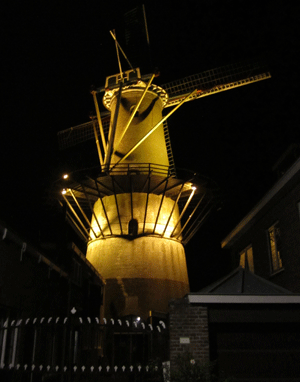 Then we made our way around Rotterdam (which having been badly bombed during WWII it is not a pretty city) to the typical 18th century ‘city’ of Zierikzee. Having received city rights in 1248, it was actually a small, quaint fishing village with just over 10,000 inhabitants. We found a nice place to stay - Hotel Zierikzee - where the very pleasant owner directed us to an excellent sea food restaurant, brasseriemaritime. It was a surprisingly elegant restaurant where we enjoyed a lovely bottle of wine and great meals – a ruit de mar shellfish dish for George and a vegetarian risotto prepared by the chef especially for Tana. (This was to be remembered as our best meal of the trip.) Aside from this great dining experience, the other thing memorable about Zierikzee is that there were contented cats visible through the windows of virtually every house.
Then we made our way around Rotterdam (which having been badly bombed during WWII it is not a pretty city) to the typical 18th century ‘city’ of Zierikzee. Having received city rights in 1248, it was actually a small, quaint fishing village with just over 10,000 inhabitants. We found a nice place to stay - Hotel Zierikzee - where the very pleasant owner directed us to an excellent sea food restaurant, brasseriemaritime. It was a surprisingly elegant restaurant where we enjoyed a lovely bottle of wine and great meals – a ruit de mar shellfish dish for George and a vegetarian risotto prepared by the chef especially for Tana. (This was to be remembered as our best meal of the trip.) Aside from this great dining experience, the other thing memorable about Zierikzee is that there were contented cats visible through the windows of virtually every house.
On Friday, September 21 we headed toward Brugge, the Belgian city that Ryan had told us about and that was famous not only for its canals but also for its beers. On the way we made one disappointing stop at Middleburg and, arriving in Brugge later in the day than we had intended, we luckily made it to the tourist office just before it closed and booked a room in what proved to be a good B&B.
Hotel Ensor was conveniently located in quiet, leafy surroundings, along a typical Brugge canal in the old town. We walked for a while, getting a feel for the place and had our first beer sitting at the bar in Cambrinus – a great pub that features a huge beer menu (400 different beers each served in its own special glass); it was a very busy with no tables for dinner available that evening (until very late) so we reserved a table for the following night.
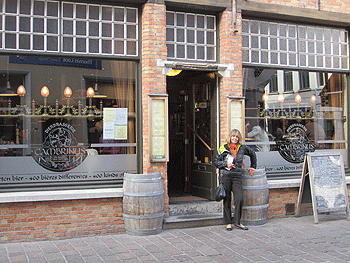
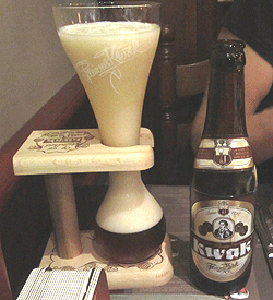
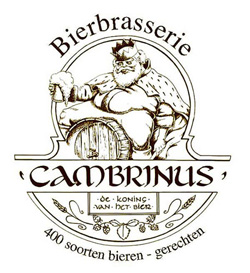
We walked to theFishmarket area and found Old Bruge – a lively restaurant with an outdoor café where we ordered white wine (as a brief break from beer) and George had fresh steamed mussels (they were in season) and Tana ordered an omelette of local cheese and mushroom. We stayed till late, went for a walk and returned just as the kitchen was closing to have dessert and a scotch.
On Saturday, September, 22nd, George was up early for a walk around the still sleeping town, getting a sense of the peaceful, beauty of the city – and a few photos:

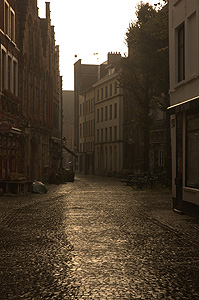
Sometimes Brugge is called "the Venice of the north" with its canals flowing in and around the old town, We decided, given the sun, to see the city from the water which we did by boat during the day and by walking the banks of the canals at night.
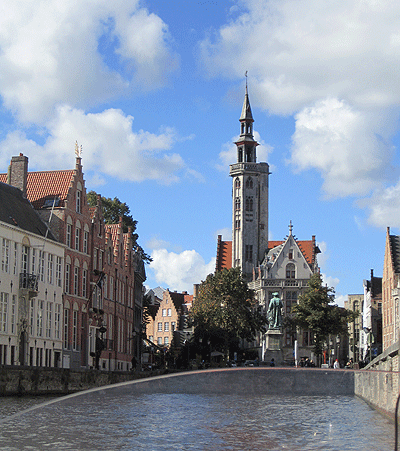
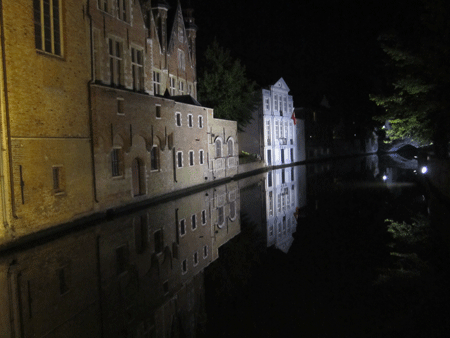
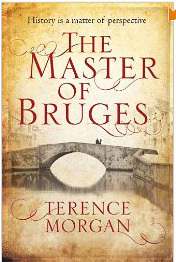
Because we had read an historical novel by Terence Morgan, The Master of Bruges, that told an intriguing (possibly true) story of the 15th century painter Hans Memling, we searched out Musea Brugge in which there is a Memling Museum. The medieval St. John's Hospital, one of the oldest still existing hospitals in Europe, where it is housed, ceased to function as a hospital only in 1978. Now primarily a museum about the old hospital, it has within the chapel area six paintings by Hans Memling.
Before heading to the pub for dinner (and several beers) we attended a concert by the Bruggian harpist Luc Vanlaere.
We had an early breakfast on Sunday, September 23 and headed across the square to meet up with the tour group for the day long “Flanders Tour of the battlefields of the Ypres Salient during the Great War” by Quasimodo Tours.
There were, in fact, three battles fought around the Ypres Salient during the War. The first, in 1914, was an attempt by the British Expeditionary Forces to halt the rapid advances made by the Germans. The second, in 1915, was notable for the first use of poison gas by the Germans. However, it is the long-planned offensive of July 31, 1917, that holds the most significance as, through a combination of over-ambitious aims, appalling weather conditions, and misguided persistence by General Douglas Haig the death toll (by the time the offensive was finally called off) had reached about 250,000. The horrors of the battle, in which many of the men drowned in liquid mud which sucked them under, has become synonymous with the images of the War.
One of the central objectives, the village of Passchendale (eventually taken on November 6 1917 by the Canadians), lent its name to the whole conflict.
The day we toured the area was fittingly grey, cloudy, and sporadically rainy and realizing that this dismal, damp weather was typical in the area and that the soldiers who had fought and died there experienced did so in similar weather, we felt particularly chilled.
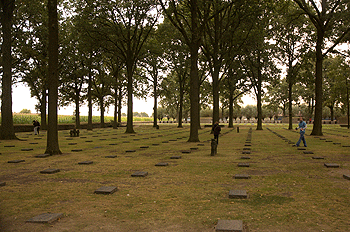 There is little evidence now of what the area was like during the War as tranquil scenes of rolling farm fields have replaced the muddy, blood drenched battlefields. All that remain are stories, photographs and several hauntingly huge cemeteries. Our first stop on the tour was a particularly remote, and incredibly sombre German cemetery where, row on row, dark grey slabs of marble mark the graves of thousands of German boys (most of them 18 years or younger) who had been sent entirely untrained into battle believing that they would be back home by Christmas. Walking through (in the rain of course) we reached the very back and paused to look at the statue standing silently just inside the fence. On the other side was a cow quietly grazing.
There is little evidence now of what the area was like during the War as tranquil scenes of rolling farm fields have replaced the muddy, blood drenched battlefields. All that remain are stories, photographs and several hauntingly huge cemeteries. Our first stop on the tour was a particularly remote, and incredibly sombre German cemetery where, row on row, dark grey slabs of marble mark the graves of thousands of German boys (most of them 18 years or younger) who had been sent entirely untrained into battle believing that they would be back home by Christmas. Walking through (in the rain of course) we reached the very back and paused to look at the statue standing silently just inside the fence. On the other side was a cow quietly grazing. 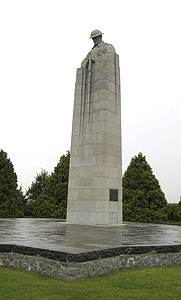
The statue pictured > is the magnificent memorial to the Canadian war dead that stands on a hill nearby.
Tyne Cot Commonwealth War Graves Cemetery and Memorial to the Missing, where we headed next was massive, sad and strangely tranquil. A Commonwealth War Graves Commission (CWGC) burial ground “for the dead of the First World War in the Ypres Salient on the Western Front,” the cemetery grounds were assigned to the United Kingdom in perpetuity by King Albert I of Belgium in recognition of the sacrifices made by the British Empire in the defence and liberation of Belgium during the war. It is the largest cemetery for Commonwealth forces in the world, for any war. The cemetery and its surrounding memorial are located outside of Passchendaele, near Zonnebeke in Belgium. The wooden crosses have been  replaced by white headstones and there were no poppies growing (as this was not the season for poppies and because, as our guide informed us, while poppies grew plentifully during and immediately after the war because they thrived when the ground was torn up and muddy, there are fewer now.) Far too many of the war dead were Canadians – many just boys as young as were the Germans.
replaced by white headstones and there were no poppies growing (as this was not the season for poppies and because, as our guide informed us, while poppies grew plentifully during and immediately after the war because they thrived when the ground was torn up and muddy, there are fewer now.) Far too many of the war dead were Canadians – many just boys as young as were the Germans.
At one point, our tour guide stopped our bus at a farm and showed us a pile of recently uncovered landmines and rusty rifles, saying that the discovery of an unexploded bomb, “the iron harvest” is an almost daily occurrence. And that it will likely be another 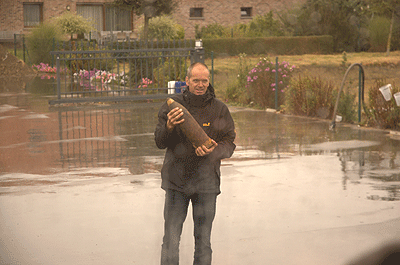 100 years before all have been removed from the ground; he also said that occasionally even now bodies of soldiers, still lying where they died in the mud, are still found.
100 years before all have been removed from the ground; he also said that occasionally even now bodies of soldiers, still lying where they died in the mud, are still found.
Our final stop on the tour was the remains of the field hospital where the Canadian doctor, John McCrae, had ministered to the wounded and where he wrote “In Flanders Fields;” it was pouring rain and very, very, damp when out guide paused at the open door to read aloud that now famous poem. On the drive back to town, people were generally silent and reflective.
It was our final night in Brugge; so we returned to our favorite pub, Cambrinus, to sample more beers (at least 4 more varieties) and enjoy another great meal - Konijn Met Bier (Belgian style rabbit)for George and cous cous kroket for Tana.
The next morning we left town a bit reluctantly but anxious to explore other parts of Belgium.
Our guide book (and several people) had recommended Tournais but, when we stopped there around noon, we found it very grey and disappointing and quickly moved on to Ath, a smaller town known as the "City of Giants" because of the "Ducasse" festivities which take place every year on the fourth weekend in August. After driving in circles in search of Hotel du Parc, we found it minus ‘the park’, booked and wandered down to the Grand Place, market square, for supper. 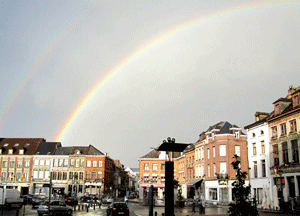 We found a restaurant - La Trattoria - that, while it did not seem particularly quaint or local, we enjoyed a very good mail of escargot and wild game wrap (for George) and 4 season pizza (for Tana)
We found a restaurant - La Trattoria - that, while it did not seem particularly quaint or local, we enjoyed a very good mail of escargot and wild game wrap (for George) and 4 season pizza (for Tana) 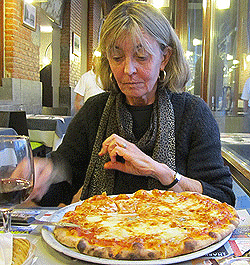 with red wine. Sitting at the window overlooking the square, we saw a double rainbow light up the evening sky which we took to be a good omen.
with red wine. Sitting at the window overlooking the square, we saw a double rainbow light up the evening sky which we took to be a good omen.
And it seems that it was a good omen for the next day, we ended up in Dinant, on the Meuse River in Namur. Dinant. It’s a wonderful town that dates back to Neolithic and then Roman times.
The city's landmark is the Collegiate Church of Notre-Dame, rebuilt in Gothic style on its old foundations after falling rocks from the adjacent cliff partially destroyed the former Romanesque style church in 1227. Behind the church rises a rock face capped by the fortified Citadel, (now accessible by a cable car or 408 the rock-hewn steps – we chose the cable car). It was built in the 11th century to control the Meuse valley because Dinant was a particularly vulnerable, strategic location on the Meuse that had been exposed to battle and pillage over the centuries.
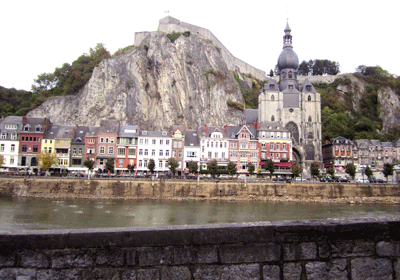 The city suffered devastation at the beginning of the First World War during which the Citadel was again used for defense and was quickly taken over to be used by the Germans. On 23 August, 674 inhabitants were summarily executed by Saxon troops of the German Army — the biggest massacre committed by the Germans in 1914. Within a month, some five thousand Belgian and French civilians were killed by the Germans on numerous similar occasions. Among the wounded was Lieut. Charles de Gaulle.
The city suffered devastation at the beginning of the First World War during which the Citadel was again used for defense and was quickly taken over to be used by the Germans. On 23 August, 674 inhabitants were summarily executed by Saxon troops of the German Army — the biggest massacre committed by the Germans in 1914. Within a month, some five thousand Belgian and French civilians were killed by the Germans on numerous similar occasions. Among the wounded was Lieut. Charles de Gaulle.
And, near the spot where the cable car arrived at the Citadel, we noticed a seemingly forgotten cemetery and wandered through the open gate to discover the graves of thousands of French and Belgian soldiers who had died there during the War.
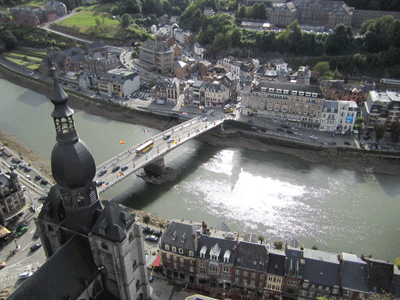
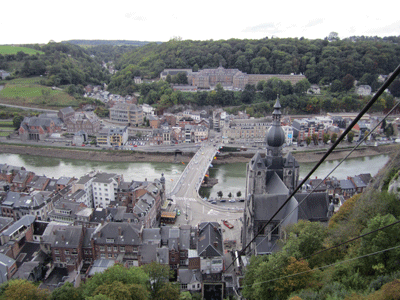
To quench a growing thirst, we made our way up the opposite bank to Maison Leffe, home of the Leffe Bier Museum. While the displays and samples were very good, it was disappointing to learn that, as in Ireland, the beer manufacturing has ceased to be a local enterprise as Leffe is now owned by InBev Belgium, the European operating arm of the global Anheuser–Busch InBev brewery giant.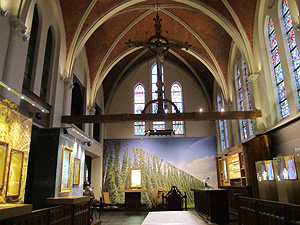
Later in the evening (after dark) we headed out to an outdoor café (protected by a canopy) that was situated right beside the magnificent (now lighted up) cliff and citadel cliff to enjoy dessert crepes and the scenery.

Wednesday, we woke to a light rain and headed off south to Boullion which had been recommended for its beauty but it was grey, and after Dinant, very disappointing. But Le Abbaye Notre-Dame d’Orval was not far away so we headed there.Dating back to the time of the Franks in the  10th century, it is still an active monastery which brews beer (the famous Trappist beer Orval) and makes cheese. It proved to be remarkably large – and stunning.
10th century, it is still an active monastery which brews beer (the famous Trappist beer Orval) and makes cheese. It proved to be remarkably large – and stunning.
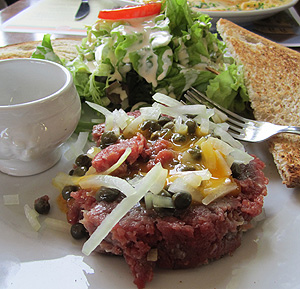 After a delicious lunch of steak tartar (for George) and a huge omelet (with Orval trappist cheese for Tana) at the nearby Orval at Hostellerie d”Orval, it was off to we headed off for Luxembourg City to visit the tunnels George had missed seeing on his last visit (30+ years ago.)
After a delicious lunch of steak tartar (for George) and a huge omelet (with Orval trappist cheese for Tana) at the nearby Orval at Hostellerie d”Orval, it was off to we headed off for Luxembourg City to visit the tunnels George had missed seeing on his last visit (30+ years ago.)
But driving into the city was a nightmare of poor signs and blocked roads. Finally we got to the Old City and stopped near the train station, usually a reliable place to find maps and info. But not this time; they had closed the tourist office.
We tried a nearby hotel to find that it was fully booked. The fellow at the reception desk gave us names of other local hotels; they were similarly full. (All had been pricy; the cheapest per night rate having been 160 euros, and the area looked very seedy.)
People had been remarkably unfriendly so we returned to the first hotel to seek help from the receptionist there because he had seemed pleasant. He told us that during the week Luxembourg is full of business and political folk now because of the EU and that on weekends it transforms into a party town – not our scene at all.
So, we asked him where to go and mentioned that we had heard of a town called Echterberg; it had been described in our guide book as the capital of “Little Switzerland” and was not far away. He pulled over his computer, went on hotels.com and booked us into a small hotel near the markt square in Echterberg and he gave us directions on how to get out of grey, crowded, unfriendly Luxembourg.
Echternach turned out to be a great spot. It is one of Europe’s earliest centres of Christianity, dating from 698. We stayed our first night at Le Pavillon Echternach, in the pedestrian area of the town centre. And enjoyed a terrific dinner in the hotel’s restaurant – La Terrine de Gibier (game meats for G) and warm chevre salad (for Tana) with a nice bottle of Riesling (the final glasses of which we took up to enjoy in our room.)
The next morning, Echternach was sunny and warm and we decided to stay another night and explore the nearby towns. Unfortunately out hotel was full but we managed to find a room at nearby Hostelliere de la Basilique and, then, took a scenic drive, stopping at Vianden, a valley town with its own chateau overlooking the river, for lunch at Café Du Pont overlooking the river.
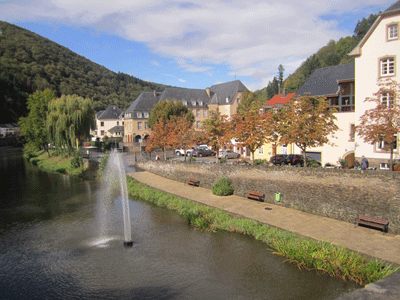
We went back to the restaurant of the previous night for dinner of grilled Dorade (G) and warm goat cheese (T) which we enjoyed with a good bottle of Riesling.
The days were running out before we had to be back in Amsterdam so we headed north on Friday through the Ardennes, the location of the famous Battle of the Bulge, one of the tragic fights that ended WWII. Bastogne is in the heart of the Ardennes and, because all seven main roads in the Ardennes mountain range converged on this small town, control of its crossroads was vital to the German attack. Outnumbered by Germans and waiting for Patton’s reinforcements, the acting commander, Brigadier General Anthony McAuliffe was confronted with a written request from German General Luttwitz for the surrender of Bastogne, his reply was one word: "NUTS!" So, there is a large statue of the General in the town centre and “NUTS” is something of a town slogan.
After a light lunch we were off to the fabulous (probably the best) war museum called “J’avais 20 ans en ’45” (“I was 20 in ‘45)” which put into light the suffering of the inhabitants as well as the army. One particularly powerful display was a mirrored room in which there were headstones.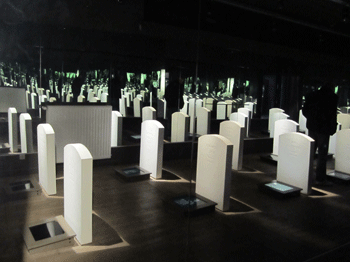 Reflected, of course, in the mirrors on all sides it appeared that the gravestones went on forever. On some, along with names, were photos of the soldiers in uniform and with families. Many were American or Belgian but a few were German and all had died in that spot during that vicious battle.
Reflected, of course, in the mirrors on all sides it appeared that the gravestones went on forever. On some, along with names, were photos of the soldiers in uniform and with families. Many were American or Belgian but a few were German and all had died in that spot during that vicious battle.
By late afternoon, dodging Brussels, we arrived in Diest, a lovely, non-touristy, very small agrarian Flemish town – staying in town at Hotel de Franse Kroonand having a dinner of Reeragout (wild deer ragout - "reeragout" - for George and something vegetarian for Tana) while watching a local 8 km race in the Markt Square.
On Saturday, we drove over the invisible border and back into the Netherlands, stopping at Nieuwpoort, described in our guide book as the smallest city in Europe. Nieuwpoort has the number of inhabitants to be called a village, but because the place was given city rights in 1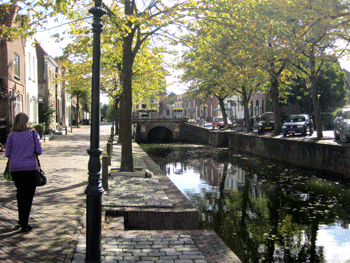 283, it still is called a city. While somewhat pretty, it was not worth stopping at but, because we were there and it was lunchtime, we sat down at the only restaurant to have a beer and a sandwich at a table on the canal.
283, it still is called a city. While somewhat pretty, it was not worth stopping at but, because we were there and it was lunchtime, we sat down at the only restaurant to have a beer and a sandwich at a table on the canal.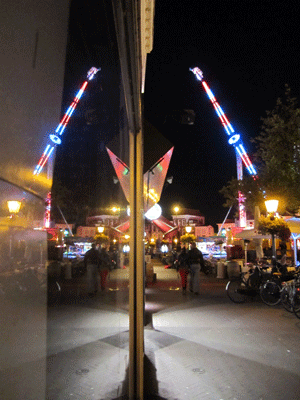
We had booked (by mistake) a hotel in Gouda – Hotel de Utrechtsche Dom – for the evening. To our dismay, What we found a loud crowded fair/amusement park with noise, lights and rides set up in what had been described in our guide book as the lovely old town square. There was nothing we liked about that event and no “dutchness” to the town and the annoyance of spending hours searching for a parking spot didn’t help lift our spirits. The only good thing in Gouda was dinner at an Italian restaurant called Roma. And the best thing was getting out of town early the next morning.
We had to be back in Amsterdam the next night so as to get our early morning flight back home on Tuesday morning; so, this was to be our last night “on the road.” We did the circle road around Amsterdam, driving North toward a Dutch fishing village of Volendam on the Zuiderzee; a famous singer who sang the praise of Volendam, had used the words: "Anyone who wants to see the real beauty of Holland, goes to Volendam.” That had made it appealing to us; we arrived early in the day with high expectations and this time we were not disappointed. We settled in to our lovely room, having been upgraded to a lovely, large room that had a great view over the old port and the water, at our hotel - Old Dutch Hotel on Walden (the dike wall).
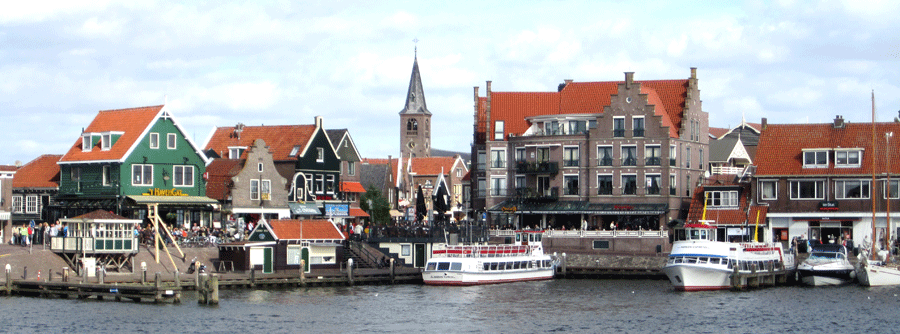
And, after taking a brief stroll through the town, we boarded a ferry to Marken – a former fishing village on a nearby small island in the Zuiderzee.

We toured the Marker Museum which gave a sense of life in the village and featured a display of traditional costumes and, after wandering through the quaint and peaceful village and enjoying a pleasant lunch at a restaurant on the lively harbour, we took the short ferry ride back to Volendam. After exploring the town and browsing in a few shops, we had a pleasant dinner in a pub and took an evening stroll along the water and, yes, it felt “Dutch.”
The next morning, Monday, we drove back to Amsterdam and, without getting lost, dropped the car off at the Rental place and walked from there to the hotel we had booked for our final night – the Best Western Leidse Square Hotel which was in a good location (near the pipe store, in the familiar old part of the City, and only a couple of blocks to the airport bus). After buying his clay pipe (actually two of them – on for a friend) and walking (again in the rain) through the City we had our final dinner at the restaurant where, on our first night, we had enjoyed the great chocolate cake. After a really good meal and a repeat of the cake, we walked back to our hotel, ready to be up at 5am to catch the airport bus.
It had been a good trip – enjoyable once we realized that the weather (lots of rain and only occasional periods of blue sky) was typical and were resigned to wearing the same clothes – rain gear (just in case) every day.
78 Mountain Ave, Hamilton, Ontario, Canada L8P4G2
All text and images are copyrighted. Any use is by permission only.
Site is under construction. Last update:
September 16, 2015